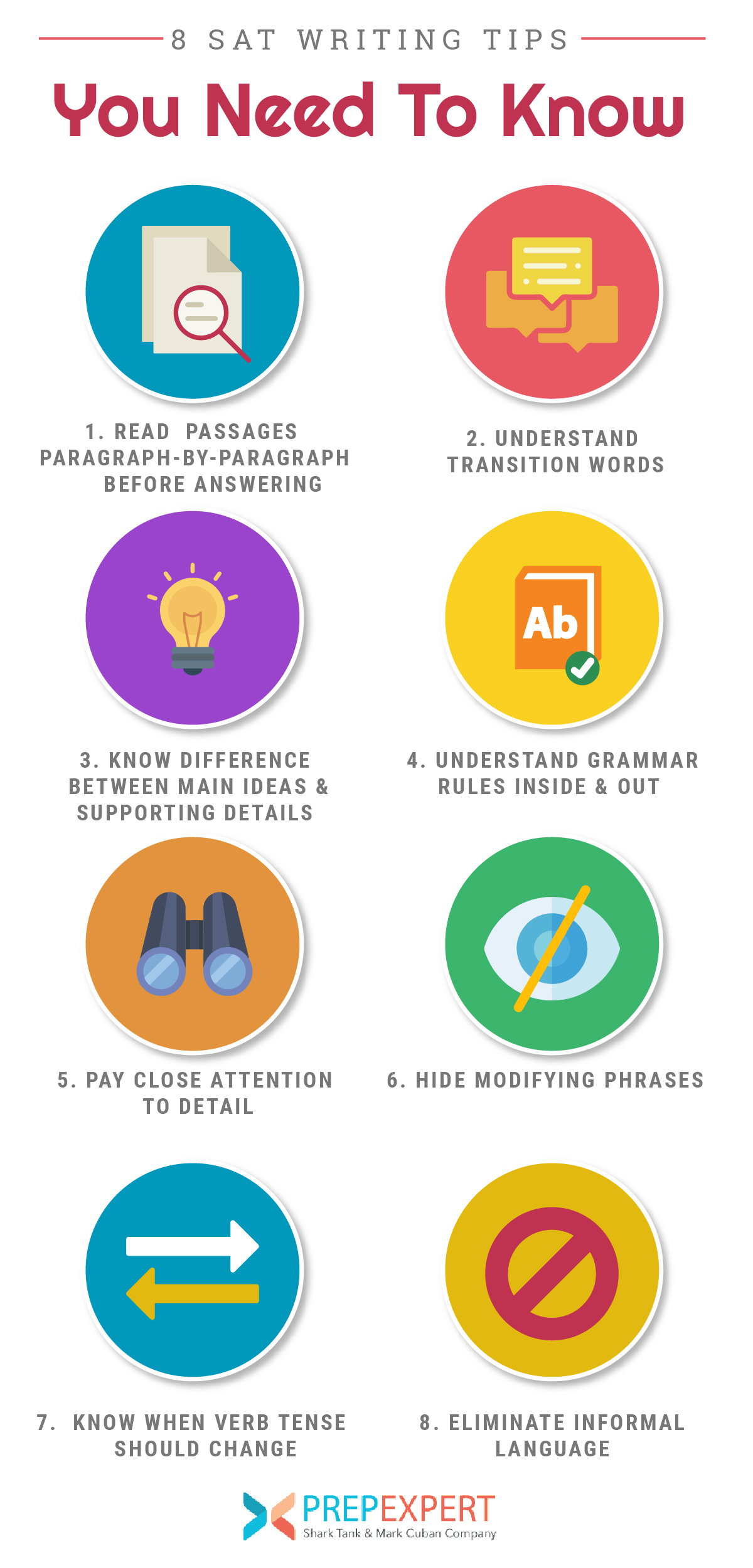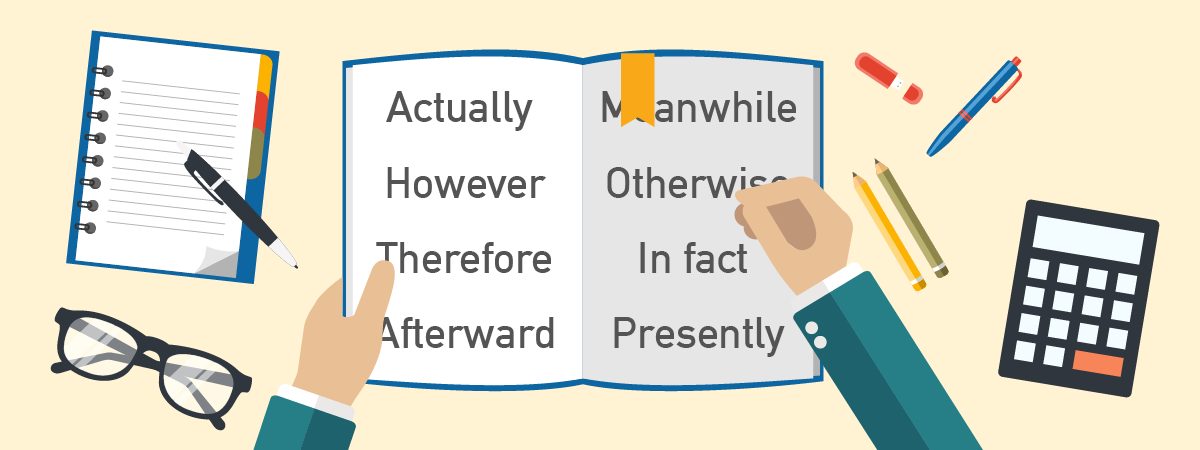8 SAT Writing Tips You Need To Know
The SAT can be a difficult exam, especially if you struggle with writing. Lucky for you, we’ve put together some of our best tips for the SAT Writing & Language test below!
You can ace the SAT Writing & Language test by answering questions paragraph-by-paragraph, understanding the rules of grammar and transition words and knowing how to differentiate between the main idea and a supporting detail.
More details on these tips below. If you need more help on the SAT Writing & Language test, consider taking an SAT prep course with Prep Expert.
[sat_one]


Read Passages Paragraph By Paragraph, Then Answer The Questions Within
Many of the SAT Writing Test’s questions require you to understand an entire paragraph to answer them correctly—so read a paragraph at a time, and then answer the questions.
Most students complete the SAT Writing test by reading passages from the beginning and answering each question as they arrive at it. However, the test will be easier to finish, and you’ll get a higher score if you wait until you’ve read entire paragraphs in full to answer questions.
The reason this strategy works because many questions are about things like the paragraph’s main idea, or transitions between ideas, where it’s necessary to understand the content of the entire paragraph, rather than merely the short underlined portion, in order to answer correctly.
In addition to providing you with more of the information you’ll need to answer questions correctly, reading paragraph-by-paragraph will also save you time. It takes up precious minutes answering question-by-question, flipping back and forth between the Scantron sheet and the test so many times. Answering questions in paragraph clusters cut this time down.

Understand The Uses Of Transition Words
Transition words—also known as conjunctions—provide clues for sentence order and paragraph organization questions.
Some of the toughest questions on the Writing Test require you to rearrange the order of sentences or paragraphs. If you struggle with these questions, conjunctions are a good way to find clues about how to answer them. Conjunctions describe the relationships between words and sentences, so they’re good markers of what information should come before or after any other information.
[leadmagnet_five]
Words like ‘but,’ or ‘however,’ for instance, indicate a contrast, so the information that follows them should contrast with the information that came before. Words like ‘therefore,’ or ‘in conclusion,’ on the other hand, announce to the reader that a point is about to be made, so they should come right before an idea is summed up.

Know The Difference Between Main Ideas & Supporting Details
The main idea is referenced repeatedly throughout a paragraph or passage, whereas a supporting detail is mentioned only once or twice.
Many of the test questions also require you to either identify the main idea of a paragraph or passage or provide supporting detail for the main point. While the distinction between the main idea and supporting detail is relatively straightforward, many students struggle with these questions.
The main idea is the thesis of a paragraph or passage—it’s the point the author is trying to prove. The main idea will be repeatedly referenced, either directly or indirectly, throughout the course of the paragraph or passage. A supporting detail provides evidence or proof in support of the main idea and is mentioned only once or twice.
Recognizing these distinctions will help you answer all those questions related to the author’s purpose, and providing support for an argument.

Know The Rules Of Grammar Inside & Out
While the rules of grammar aren’t the most exciting thing in the world, knowing them inside and out will help you immensely on the SAT Writing & Language test.
Many students—including those who are excellent students of writing and English—rely on their ‘ear’ to tell them where to insert a comma or use a semicolon. While this method works most of the time, knowing the rules of grammar—where to put commas and other punctuation marks, how to place modifying phrases, preserve parallelism, match verb with the subject, et cetera—will ensure that you don’t get any problems on the test wrong.
Don’t worry if you didn’t learn these grammar rules in school, or if you learned them so long ago you’ve practically forgotten them. The rules themselves—especially those that are immediately relevant for the Writing Test—are relatively easy to learn, something you can do in a few hours.
If you’re struggling on your own, you can always sign up for classes or tutoring with Prep Expert, and have one of our expert instructors help you navigate the rules of the English language.

Pay Close Attention To Detail
Know the difference between words like ‘its’ and ‘it’s,’ or you will lose lots of points on the Writing test.
A bunch of questions on the Writing test boils down to very minor details—for example, where do commas go, or what verb tense is most appropriate. To give perhaps the most salient example, many of my students, no matter how many times I remind them, consistently get the difference between the words ‘its’ and ‘it’s’ wrong. ‘Its’ is the possessive form of the pronoun ‘it’ (for example, “The dog wagged its tail”), whereas ‘it’s’ is a contraction for the words ‘it is’ (as in, “It’s raining outside”).
[sat_two]
If you go too fast on the Writing test, you’re going to miss many of these small distinctions and lose a lot of points in the process. Be sure then to keep a deliberate pace, and double-check that you’ve made the right choice before you bubble it in on your Scantron sheet.
To assuage your fears about time, I can tell you that most of my students have no trouble finishing the Writing test on time. While the Reading and Math tests are rather time-sensitive, the Writing Test requires much less re-reading and has fewer two-step critical thinking questions, so it’s more doable time-wise.

Hide Modifying Phrases To Easily Spot Subject-Verb & Noun-Pronoun Errors
If you boil sentences down to their basic parts by hiding modifying phrases, it’ll be easier for you to notice grammatical mistakes.
Lots of Writing questions relate to subject-verb disagreement or noun-pronoun disagreement. For example, if you have a plural subject, such as ‘dogs,’ you need to use a plural verb like ‘run,’ rather than the singular verb ‘runs,’ in association with it.
Or, if you use a singular noun like ‘brother,’ you need to use a singular pronoun, such as ‘his,’ rather than a plural pronoun, like ‘their,’ in association with it. In order to make the exam more difficult, the College Board hides many of these mistakes—which are readily noticeable when they appear relatively close to each other in a sentence—behind modifying phrases.
Here’s an example: “My sisters, who just got a new dog, likes animals.” In this incorrect sentence, a singular noun (‘likes’) is paired with a plural subject (‘sisters’). However, because the modifying phrase (“who just got a new dog”) ends with a singular subject, some students will be thrown off and see no problem with the subject/verb pairing.
In order to avoid making similar mistakes, a simple trick is to block out the modifying phrase with your finger or draw a line through it with your pencil. Modifying phrases always follow the subject that they modify, and are preceded and succeeded by matching punctuation marks (usually commas, but sometimes dashes or parentheses.)
Hiding these phrases boils a sentence down to its bare parts (subject, verb), and makes it much easier to spot mistakes. Now, look at my sentence without the modifier: “My sisters likes animals.” See? This makes the problem much easier to spot.

Know That Verb Tense Should Change Under Only Two Circumstances
Be aware of the two situations where verb tense should shift: only when a time word or a condition word is used.
The Writing test includes questions requiring you to spot errors in verb tense—when the tense of a sentence or paragraph has incorrectly shifted into the past or future. In order to answer these questions correctly, know that in general, whatever tense a piece of writing is written in—past, present, future, or any of their variations—it should stay in, except under two circumstances.
The verb tense of a sentence or paragraph can shift if a time word, or a condition word, is used. For example, if I’m writing in the present tense, but then use the condition word ‘if,’ I have a reason to switch into the future tense. Or, if I use the time words ‘last Wednesday,’ I have a reason to shift into the past tense.
Look out for these two types of words to help you determine whether a shift in verb tense is appropriate. If not, you’ll want to select an answer choice that corrects the error.

Look Out For, And Eliminate Informal Language
Eliminating informal language helps preserve the tone of paragraphs and passages.
The Writing test wants to see that you know how to identify and maintain tone throughout the course of a paragraph or passage. Each passage on the test should have a formal, academic tone.
If you see a word like ‘icky,’ know that it needs to be replaced with a more formal, academic word, such as ‘unappetizing’ or ‘unpalatable.’ Even when a passage is written in a personal way, slang or casual language still has no place.
[sat_three]
For more test strategy, college admissions, and scholarship application tips sign up for our FREE class happening right now!
Written by Todd Marcus
More from Todd Marcus

Taking The ACT Junior Year
If you're ambitious and want to give yourself plenty of time for score improvement, then consider taking the ACT junior…

ACT 2020 Score Release Dates
Here then are the ACT 2020 score release dates to plan around, as well as, the different kinds of available…

How To Determine Your Average SAT Study Time
If you want a high score on the SAT, then you need to put in the hours. There's no way…